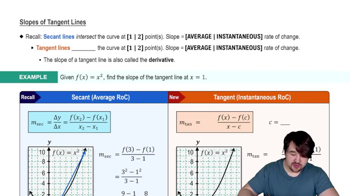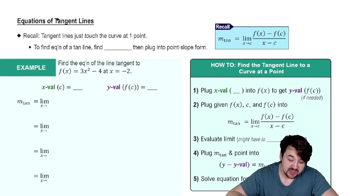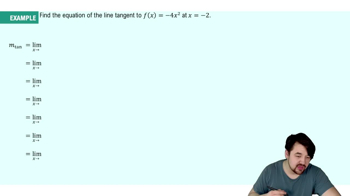Table of contents
- 0. Functions7h 52m
- Introduction to Functions16m
- Piecewise Functions10m
- Properties of Functions9m
- Common Functions1h 8m
- Transformations5m
- Combining Functions27m
- Exponent rules32m
- Exponential Functions28m
- Logarithmic Functions24m
- Properties of Logarithms34m
- Exponential & Logarithmic Equations35m
- Introduction to Trigonometric Functions38m
- Graphs of Trigonometric Functions44m
- Trigonometric Identities47m
- Inverse Trigonometric Functions48m
- 1. Limits and Continuity2h 2m
- 2. Intro to Derivatives1h 33m
- 3. Techniques of Differentiation3h 18m
- 4. Applications of Derivatives2h 38m
- 5. Graphical Applications of Derivatives6h 2m
- 6. Derivatives of Inverse, Exponential, & Logarithmic Functions2h 37m
- 7. Antiderivatives & Indefinite Integrals1h 26m
- 8. Definite Integrals4h 44m
- 9. Graphical Applications of Integrals2h 27m
- 10. Physics Applications of Integrals 2h 22m
2. Intro to Derivatives
Tangent Lines and Derivatives
Problem 3.2.73c
Textbook Question
Vertical tangent lines If a function f is continuous at a and lim x→a| f′(x)|=∞, then the curve y=f(x) has a vertical tangent line at a, and the equation of the tangent line is x=a. If a is an endpoint of a domain, then the appropriate one-sided derivative (Exercises 71–72) is used. Use this information to answer the following questions.
73. {Use of Tech} Graph the following functions and determine the location of the vertical tangent lines.
c. f(x) = √|x-4|
 Verified step by step guidance
Verified step by step guidance1
Step 1: Understand the problem. We need to find the location of vertical tangent lines for the function f(x) = \sqrt{|x-4|}. A vertical tangent line occurs where the derivative of the function approaches infinity.
Step 2: Analyze the function. The function f(x) = \sqrt{|x-4|} is continuous everywhere in its domain, which is all real numbers. However, the expression inside the square root, |x-4|, changes behavior at x = 4.
Step 3: Find the derivative of the function. To find where the vertical tangent line occurs, we need to compute the derivative f'(x). Start by rewriting the function as f(x) = (|x-4|)^{1/2}. Use the chain rule and the derivative of the absolute value function to find f'(x).
Step 4: Evaluate the behavior of the derivative at x = 4. Since the absolute value function has a corner at x = 4, check the limit of the derivative as x approaches 4 from both sides. Specifically, calculate \lim_{x \to 4^-} f'(x) and \lim_{x \to 4^+} f'(x).
Step 5: Determine the location of the vertical tangent line. If either of the one-sided limits from Step 4 approaches infinity, then there is a vertical tangent line at x = 4. The equation of this vertical tangent line is x = 4.
 Verified video answer for a similar problem:
Verified video answer for a similar problem:This video solution was recommended by our tutors as helpful for the problem above
Video duration:
6mPlay a video:
Was this helpful?
Key Concepts
Here are the essential concepts you must grasp in order to answer the question correctly.
Vertical Tangent Lines
A vertical tangent line occurs at a point on a curve where the slope of the tangent approaches infinity. This typically indicates that the derivative of the function is undefined or infinite at that point. In the context of calculus, if the limit of the absolute value of the derivative approaches infinity as x approaches a certain value, the function has a vertical tangent line at that point.
Recommended video:

Slopes of Tangent Lines
Continuity of Functions
A function is continuous at a point if there are no breaks, jumps, or holes in the graph at that point. For a function to have a vertical tangent line, it must first be continuous at the point of interest. This means that the function's value at that point is well-defined, and the behavior of the function around that point can be analyzed using limits.
Recommended video:

Intro to Continuity
One-Sided Derivatives
One-sided derivatives are used to analyze the behavior of a function at endpoints or points where the function may not be differentiable in the traditional sense. The left-hand derivative considers the slope of the tangent as you approach the point from the left, while the right-hand derivative does so from the right. In cases where a function is defined only on one side of a point, one-sided derivatives provide crucial information about the function's behavior at that point.
Recommended video:

One-Sided Limits

 5:13m
5:13mWatch next
Master Slopes of Tangent Lines with a bite sized video explanation from Nick
Start learningRelated Videos
Related Practice



